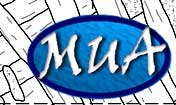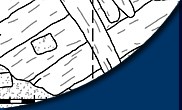
Excavations on EPII and Brick Wreck
30 June -3 July 2008
By Team 1:
Chris Barron, Amanda Wohlberg, and Jake Shidner

Amanda weighing and recording ballast from EPII.
Monday began like so many other days have ended, with cloudy skies and threatening weather. Instead of diving, we revisited the lab as we had on the previous Friday. We started the day with lectures and presentations from both Wayne Abrahamson and Kendra Kennedy. Wayne presented on the Seminole wreck, a late 19th century eastern coastal side-wheel steamboat mostly likely used to transport supplies, among other things, to the lumber camps that were present in the area during that time along the Blackwater River in Baldwin County, Alabama. Kendra followed with a presentation about the maritime cultural landscape of Pensacola, Florida. She has used GIS to overlay different maps and compare them to the current maritime coastal landscape and environment. Following the lectures we spent some time in the lab doing various tasks recording, conserving, and organizing artifacts and documents. Chris drew several concretions and recorded them, Amanda did inventory of artifacts in the refrigerator and freezer, and Jake did work cleaning several copper artifacts.
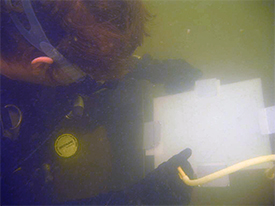
Student recording underwater.
Tuesday’s weather was better and resulted in a long day of good work on and in the water. Amanda spent today with Kendra and others diving on a site near the Pensacola waterfront, a large ballast pile. On the rock pile ballast, some ceramics, marine life, and other cultural materials were noted. Later they attempted to dive on several targets nearby but were unsuccessful due to poor diving conditions. On the EP II site, the final drawing was made of the northern unit, 100N 486 E. Due to the possibility of the timbers discovered in that unit, a new unit was opened directly to the north. Work began on this unit, 101N 486 E, very quickly. As we have become more skilled with the dredges, we are able to work more efficiently. The first team to dredge the unit completed the first 20 centimeter level, and as work progressed through the 20 to 40 centimeter level, wood timbers were uncovered. After clearing the wood for a better feel and more certainty we decided to discontinue dredging in hopes that in better visibility more care could be taken in excavating around the wooden timbers. We made a quick rough sketch of the unit before ending dive operations for the day.
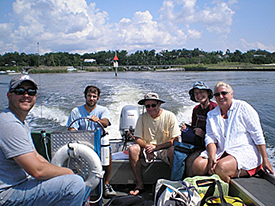
Students and staff heading out to UWF barge.
On Wednesday, it was Chris’s turn to explore the Pensacola waterfront and dive on the ballast piles. Amanda and Jake continued work on the new north unit on EPII. Unlike the south unit, very few pieces of ballast or other artifacts are recovered. The goal of these northern units is to hopefully determine exactly where the bow of the ship is, which will help determine the overall length and size of the vessel. After more dredging on the unit, more timbers were uncovered and defined. There is a possible “knee” in the unit, a curved timber with a distinctive shape that helped to support the hull, flooring, and other deck timbers. If the timber turns out to be a knee, that may help to define where this unit is located in regards to the vessel. As the day progressed, the currents became stronger and stronger. As the final dive of the day was ending, it took the total effort of all the students on the barge to recover the equipment. It was a day that reminded all of us how difficult and stressful it can be as a diver, constantly working in strong currents and rough conditions.
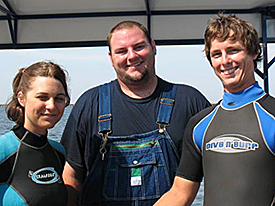
Team 1: Amanda, Jake, and Chris.
Thursday was the final day of our work week, as Friday was the 4th of July, a holiday. Due to more bad weather, it was decided that our day would be best spent thoroughly cleaning our equipment, a weekly ritual. Special attention was paid to all of the closets where we store our gear. All of the gear was removed, the rooms cleaned and everything reorganized. It is important to take good care of the equipment, as not only the quality of work depends on it, but our lives depend on some of it as well. At the end of every week, all of our equipment is thoroughly scrubbed and cleaned beyond what we clean it on a daily basis. This keeps our dredges, boats, trucks, and other archaeological equipment it good working order.
Hopefully, next week will bring good weather that will allow us to further our investigations on EP II, as well as continuing survey in the bay and investigating various targets and known sites along the waterfront.
Please feel free to contact us if you have any questions or concerns at: mua@keimaps.com.
Return to Project Journal home page.
